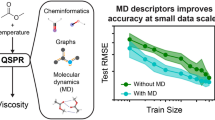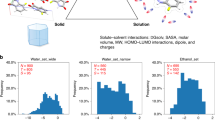Abstract
The Flory-Huggins interaction parameter \(\chi\) for polymer-solvent mixtures captures the nature of interactions and provides insights on solubility. \(\chi\) is usually estimated using experimental or (empirical) computational methods, which may be expensive, time-consuming or inaccurate. Here, we built a machine learning (ML) model to instantly predict temperature-dependent \(\chi\) for a given polymer-solvent pair. The ML model was trained using 1586 experimental polymer-solvent datapoints, and a hierarchical polymer and solvent fingerprinting scheme. Extensive testing has been performed to verify the accuracy and generality of this model. This work demonstrates an ML model that can progressively be improved as new data emerges.
Graphical Abstract








Similar content being viewed by others
Data availability
The compiled \(\chi\) dataset has been made available in the Supplemental Information.
References
L. Robeson, Applications of polymer blends: emphasis on recent advances. Polym. Eng. Sci. 24, 587–597 (1984). https://doi.org/10.1002/pen.760240810
G. Fredrickson, A. Liu, F. Bates, Entropic corrections to the Flory-Huggins theory of polymer blends: architectural and conformational effects. Macromolecules 27, 2503–2511 (1994). https://doi.org/10.1021/ma00087a019
E. Favre, P. Schaetzel, Q. Nguygen, R. Clement, J. Neel, Sorption, diffusion and vapor permeation of various penetrants through dense poly (dimethylsiloxane) membranes: a transport analysis. J. Membr. Sci. 92, 169–184 (1994). https://doi.org/10.1016/0376-7388(94)00060-3
R. Mathias, D. Weber, K. Thompson, B. Marshall, M. Finn, J. Scott, R. Lively, Framework for predicting the fractionation of complex liquid feeds via polymer membranes. J. Membr. Sci. 640, 119767 (2021). https://doi.org/10.1016/j.memsci.2021.119767
B. Yan, X. Cao, Phase diagram of novel recycling aqueous two-phase systems composed of two pH-response polymers: experiment and modeling. Fluid Phase Equilib. 364, 42–47 (2014). https://doi.org/10.1016/j.fluid.2013.11.037
N. Schuld, B. Wolf, Polymer-solvent interaction parameters. Polym. Handb. (1999). https://doi.org/10.1002/0471532053.bra052
A. Patwardhan, L. Belfiore, Prediction of thermodynamic properties of polymer solutions by a group-contribution method. J. Polym. Sci. B Polym. Phys. 24, 2473–2486 (1986). https://doi.org/10.1016/0032-3861(87)90049-8
R. Sman, Predicting the solubility of mixtures of sugars and their replacers using the Flory-Huggins theory. Food Funct. 8, 360–371 (2017). https://doi.org/10.1039/C6FO01497F
C. Sheehan, A. Bisio, Polymer/solvent interaction parameters. Rubber Chem. Technol. 39, 149–192 (1966). https://doi.org/10.5254/1.3544827
R. Orwoll, P. Arnold, Polymer-solvent interaction parameter, in Physical properties of polymers handbook. (Springer, New York, 2007), pp.233–257
C. Callaway, K. Hendrickson, N. Bond, S. Lee, P. Sood, S. Jang, Molecular modeling approach to determine the Flory-Huggins interaction parameter for polymer miscibility analysis. ChemPhysChem 19, 1655–1664 (2018). https://doi.org/10.1002/cphc.201701337
D. Kozuch, W. Zhang, S. Milner, Predicting the Flory-Huggins \(\chi\) parameter for polymers with stiffness mismatch from molecular dynamics simulations. Polymers 8, 241 (2016). https://doi.org/10.3390/polym8060241
A. Ravichandran, C. Chen, R. Khare, Prediction of \(\chi\) parameter of polymer blends by combining molecular simulations and integral equation theory. J. Phys. Chem. 122, 9022–9031 (2018). https://doi.org/10.1021/acs.jpcb.8b06684
S. Jawalkar, S. Adoor, M. Sairam, M. Nadagouda, T. Aminabhavi, Molecular modeling on the binary blend compatibility of poly (vinyl alcohol) and poly (methyl methacrylate): an atomistic simulation and thermodynamic approach. Am. J. Phys. Chem. 109, 15611–15620 (2005). https://doi.org/10.1021/jp051206v
Polymerdatabase temperature and concentration dependence of interaction parameter. Solubility and interaction parameters. https://polymerdatabase.com/polymer%20physics/Scott%20Hildebrand.html. Accessed 23 Apr 2022
R. Batra, L. Song, R. Ramprasad, Emerging materials intelligence ecosystems propelled by machine learning. Nat. Rev. Mater. 6, 655–678 (2021). https://doi.org/10.1038/s41578-020-00255-y
L. Chen, G. Pilania, R. Batra, T. Huan, C. Kim, C. Kuenneth, R. Ramprasad, Polymer informatics: current status and critical next steps. Mater. Sci. Eng. R Rep. 144, 100595 (2021). https://doi.org/10.1016/j.mser.2020.100595
T. Huan, A. Mannodi-Kanakkithodi, R. Ramprasad, Accelerated materials property predictions and design using motif-based fingerprints. Phys. Rev. B Condens. Matter. 92, 014106 (2015). https://doi.org/10.1103/PhysRevB.92.014106
J. Brandrup, E. Immergut, E. Grulke, A. Abe, D. Bloch, Polymer handbook (Wiley, New York, 1999), pp.V1–V6
Materials Genome Project. Flory-Huggins Chi (\(\chi\)) Database. https://pppdb.uchicago.edu/chi. Accessed 23 Apr (2022)
S. Gündüz, S. Dincer, Solubility behaviour of polystyrene: thermodynamic studies using gas chromatography. Polymer 21, 1041–1046 (1980). https://doi.org/10.1016/0032-3861(80)90035-X
R. Kokes, A. DiPietro, F. Long, Equilibrium sorption of several organic diluents in polyvinyl acetate. J. Am. Chem. Soc. 75, 6319–6321 (1953)
C. Grozea, I. Li, D. Grozea, G. Walker, Microdomain orientation of diblock copolymer ultrathin films solvent annealed at low temperatures. Macromolecules 44, 3901–3909 (2011). https://doi.org/10.1021/ma102470v
C. Caddeo, A. Mattoni, Atomistic investigation of the solubility of 3-alkylthiophene polymers in tetrahydrofuran solvent. Macromolecules 46, 8003–8008 (2013). https://doi.org/10.1021/ma401345n
J. Emerson, D. Toolan, J. Howse, E. Furst, T. Epps III., Determination of solvent–polymer and polymer–polymer Flory-Huggins interaction parameters for poly (3-hexylthiophene) via solvent vapor swelling. Macromolecules 46, 6533–6540 (2013). https://doi.org/10.1021/ma400597j
K. Secrist, A. Nolte, Humidity swelling/deswelling hysteresis in a polyelectrolyte multilayer film. Macromolecules 44, 2859–2865 (2011). https://doi.org/10.1021/ma101983s
L. Yen, J. McKetta Jr., A thermodynamic correlation of nonpolar gas solubilities in polar, nonassociated liquids. AIChE J. 8, 501–507 (1962). https://doi.org/10.1002/aic.690080416
Y. Xuan, J. Peng, L. Cui, H. Wang, B. Li, Y. Han, Morphology development of ultrathin symmetric diblock copolymer film via solvent vapor treatment. Macromolecules 37, 7301–7307 (2004). https://doi.org/10.1021/ma0497761
H. Doan Tran, C. Kim, L. Chen, A. Chandrasekaran, R. Batra, S. Venkatram, D. Kamal, J. Lightstone, R. Gurnani, P. Shetty et al., Machine-learning predictions of polymer properties with polymer genome. Int. J. Appl. Phys. 128, 171104 (2020). https://doi.org/10.1063/5.0023759
M. Tian, P. Munk, Characterization of polymer-solvent interactions and their temperature dependence using inverse gas chromatography. J. Chem. Eng. Data. 39, 742–755 (1994). https://doi.org/10.1021/je00016a024
D. Tomlin, C. Roland, Negative excess enthalpy in a van der Waals polymer mixture. Macromolecules 25, 2994–2996 (1992). https://doi.org/10.1021/ma00037a033
R. Batra, H. Tran, C. Kim, J. Chapman, L. Chen, A. Chandrasekaran, R. Ramprasad, General atomic neighborhood fingerprint for machine learning-based methods. J. Phys. Chem. C 123, 15859–15866 (2019). https://doi.org/10.1021/acs.jpcc.9b03925
F. Pedregosa, G. Varoquaux, A. Gramfort, V. Michel, B. Thirion, O. Grisel, M. Blondel, P. Prettenhofer, R. Weiss, V. Dubourg, J. Vanderplas, A. Passos, D. Cournapeau, M. Brucher, M. Perrot, E. Duchesnay, Scikit-learn: machine learning in python. J. Mach. Learn. Res. 12, 2825–2830 (2011)
C. Hansen, Hansen Solubility Parameters: A User’s Handbook (CRC Press, Boca Raton, 2007), pp.507–510
A. Chandrasekaran, C. Kim, S. Venkatram, R. Ramprasad, A deep learning solvent-selection paradigm powered by a massive solvent/nonsolvent database for polymers. Macromolecules 53, 4764–4769 (2020). https://doi.org/10.1021/acs.macromol.0c00251
Acknowledgments
The authors would like to thank ExxonMobil Research and Engineering for their support. We would also like to acknowledge Dr. Ronita Mathias from the Lively lab at Georgia Institute of Technology, for their valuable feedback. We also thank Joseph Kern and Chiho Kim from the Ramprasad Group at Georgia Institute of Technology, for their indispensable inputs.
Funding
This study was funded by ExxonMobil Research and Engineering.
Author information
Authors and Affiliations
Corresponding author
Ethics declarations
Conflict of interest
The authors declare no competing interests.
Supplementary Information
Below is the link to the electronic supplementary material.
Rights and permissions
Springer Nature or its licensor holds exclusive rights to this article under a publishing agreement with the author(s) or other rightsholder(s); author self-archiving of the accepted manuscript version of this article is solely governed by the terms of such publishing agreement and applicable law.
About this article
Cite this article
Nistane, J., Chen, L., Lee, Y. et al. Estimation of the Flory-Huggins interaction parameter of polymer-solvent mixtures using machine learning. MRS Communications 12, 1096–1102 (2022). https://doi.org/10.1557/s43579-022-00237-x
Received:
Accepted:
Published:
Issue Date:
DOI: https://doi.org/10.1557/s43579-022-00237-x




